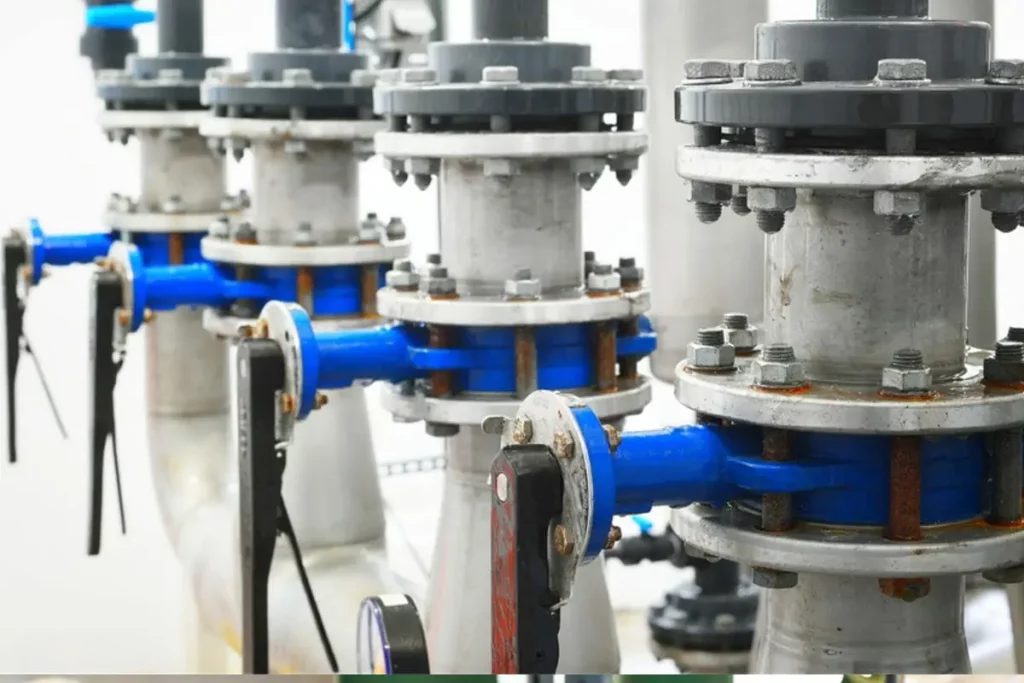Butterfly valves control the flow of various types of fluids in applications by a quarter-turn motion. These valves offer a range of advantages compared to other industrial valves, making them appropriate for several applications. Choosing butterfly valves is a process of evaluating your application needs and selecting the appropriate valve against the required features.
At John Valves, we manufacture and supply butterfly valves in different styles and sizes to help customers manage their varying needs. In this article, we discuss five factors to consider when choosing butterfly valves.
What are butterfly valves?
The butterfly valve gets its name from the wing-like action of the disc as it turns in a quarter-turn rotational motion. Butterfly valves are quick and easy to open and close, and operators can use them to start, stop and regulate flow. Butterfly valves can be used in their complete open or closed positions and even for non-critical throttling applications.
Butterfly valves have some excellent benefits in comparison to gate valves, globe valves and ball valves. They’re lightweight, which means that most systems can easily support them, and they’re typically less expensive and take up less space. Butterfly valves are also easy to maintain, consisting of minimal moving parts with no internal cavities for fluids to become trapped. These valves are suitable for many different fluid systems, including liquids containing large amounts of suspended solids and even slurries.
Choosing butterfly valves
To make sure you have the most suitable butterfly valve for your application, consider the following factors when choosing butterfly valves:
Body style
Butterfly valves can come in various body styles to suit varying needs of piping systems. Some valves are required along the middle of a process line, sandwiched between two adjacent pipe flanges. These non-threaded butterfly valves are known as ‘wafer style’ and are lightweight, making them a cheaper cost option and are easier to install, thereby reducing installation costs.
In comparison, lug butterfly valves have protruding lugs on the body so that they can be bolted onto the pipe flanges by two separate sets of bolts, which makes them suitable for ‘dead-end’ services or where removal of downstream piping may be required. These valves have a higher initial cost, but their functionality makes them ideal for those needing the dead-end service option.
Materials
Butterfly valves are made from various materials, and it’s important to consider how these materials will function in your environment when choosing butterfly valves. Valves can be non-metallic or metallic, and the most common materials for valves is ductile iron or carbon steel since they are readily available and affordable. However, these materials are not corrosion-resistant, so you should opt for stainless steel butterfly valves in applications prone to corrosion. Stainless steel may cost more, but it’s resistant to both corrosion and high temperatures. In extreme conditions, where pressure drop and corrosion are extensive, a butterfly valve made of special allows may be required.
Type of media
Before purchasing valves, it’s vital to know what fluid travels through your application, whether that’s a liquid, gas or slurry. The type of media will affect how proficient the seal of the valve is. Butterfly valves used for gas systems require a minimum specified leakage rate at a specific operating temperature and pressure. Valves for liquids need a tight seal to prevent liquids from leaking.
On the other hand, valves for solids must have a seal that sits flush within the pipe to avoid the obstruction of the flow and prevent the materials from piling up at the valve. Solids are also prone to wear down the valve seat faster, and dry materials may jam between the disc and the seat, making larger valves more suitable for solids.
Pressure drop
Pressure drop refers to the change in fluid pressure between the inlet and outlet of the valve. It’s an important consideration when selecting the size of the butterfly valve needed. For flow regulating applications, if the pressure drop across the fully opened valve isn’t large enough, the valve will not be able to control or alter the fluid flow to any extent until it is near the fully closed position. In this case, you should choose a valve with a smaller opening.
Speed of operation
Consider your operational speed and application requirements before choosing butterfly valves. If your system must be quickly isolated or stopped, a fast-acting actuator on your butterfly valve is needed. Fast action can be provided by hydraulic or pneumatic actuators in combination with a solenoid valve. Electrical actuators can also provide reasonably fast actuation when the motor speed of the actuator is high. Fast-acting valves are not suitable for regulating the flow of fluids.
If you don’t require fast isolation features but controlling the flow at regulated speeds is a priority, then a slow-acting actuator on your butterfly valve would suit your application.
Summary
Butterfly valves offer many significant advantages compared to other common types of valves, and they’re also cost-efficient and lightweight. They’re the best choice for many applications, and they come in various styles and sizes, which are designed to make them as efficient as possible. Hopefully, this article has helped you distinguish the style and needs of your butterfly valves so you can choose the most suitable valve. If you need help selecting a valve, please get in touch with John Valves – we’ve been helping businesses select suitable valves for 125 years.

